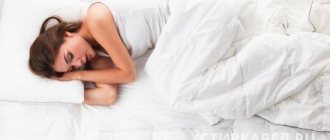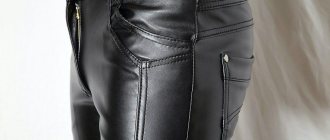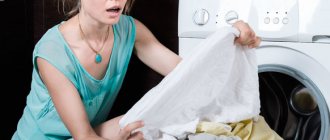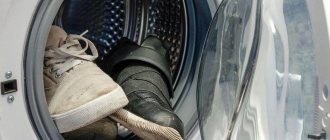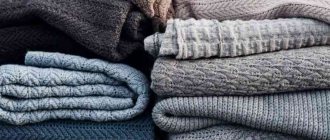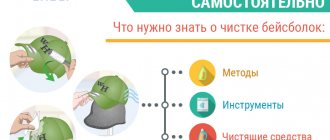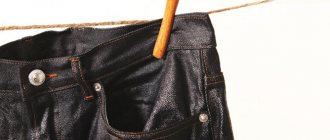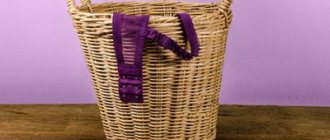Natural fabrics are highly environmentally friendly, they are comfortable, practical, and back in fashion.
With proper care, this material has a long service life, becoming softer and more pleasant over time. The question arises - how to wash linen so as not to spoil it?
In this article we will tell you whether and how to properly wash linen in a washing machine and by hand, and at what degrees linen items should be washed.
Material properties
The fabric has the following features:
- Made from natural fibers, therefore environmentally friendly.
- Has antistatic properties.
- Breathability - thanks to the porous structure, oxygen is easily transported through it, which allows the skin to breathe.
- It has antiseptic characteristics; mold or mildew does not appear on it.
- Good thermal conductivity. The outfit is recommended to be worn in hot weather. Matter keeps the temperature of the human body within comfortable limits.
- Wear resistance. A robe made from such fabric lasts for years.
Features of fabric behavior when washing, choice of temperature and detergents
Despite the large number of positive aspects, this type of material has a significant drawback. Often, when washing, it shrinks so much that the situation cannot be corrected. But this only happens if all recommendations have not been followed.
There are nuances, knowing which you can clean the product without negative consequences:
- Linen washing should be done in warm water (no more than 30 degrees);
- the manual process requires the use of a large amount of liquid;
- It is recommended to wash colored materials with special products for such fabrics;
- The use of chlorine-containing bleaches is strictly prohibited.
You can find out whether linen shrinks when washed in another way - wet a piece of fabric sewn on the wrong side of the product and see its reaction to the product.
What do you need to know?
Do not use products containing chlorine to wash linen products. Upon contact with it, fabric fibers lose strength. You should be especially careful when choosing stain removers and bleaches, since they often contain chlorine.
Products with the addition of synthetic fibers increase the elasticity of the fabric and make it easier to care for: it is easier to iron and does not shrink after washing. However, such a thing loses the main qualities that make linen so valuable - naturalness, strength and hypoallergenicity.
Selecting the type of wash
In most cases, housewives choose an automated process. Their desire is understandable, since there is no need to waste time and effort to wash away stubborn dirt. But unfortunately, this is not the case. Linen is a rather capricious material.
It is better to wash it by hand, because serious mistakes are often made, which is why the outfit shrinks hopelessly. The label sewn on the reverse side will tell you how to wash linen - by hand or in a machine.
Important: the automated process is permitted only for those products that have a corresponding mark on the tag.
Is it permissible to wash
Linen is a rare material that only benefits from washing. Staying in soapy water at room temperature makes it softer and more pleasant to the body. For most products, both manual and machine cleaning is acceptable. In this case, the first one is the most preferable.
To make sure you don’t make a mistake with washing, pay attention to the manufacturer’s recommendations indicated on the label. Usually the optimal water temperature is already written there, and whether the product can be wrung out and ironed. Owners of dyed and embroidered linen should pay particular attention to this.
Wash by hand
This type is most preferable for delicate fabrics, since during the process you can control the reaction of the material to the selected product.
Mode of application:
- Pour a large amount of warm water into the basin (for colored material - no higher than 30, without color - 40-50 degrees).
- If granular powder is used, you should first dissolve it in 200 ml of hot water, and then add the liquid to the container. But it is still recommended to use gel-like products, since they do not leave grains and are washed out better.
- Gently wipe the surface of the fabric to remove dirt. When washing, soft brushes or foam sponges are used.
- After the procedure, you need to rinse the linen with warm water, preferably running water. During the final rinse, add fabric softener to make the fabric softer.
Household chemicals for colored and white products
It is not difficult to find several products on sale that will take good care of linen fabrics.
"Sarma"
It is one of the gels suitable for manual process. Designed for light-colored fabrics, as it contains bleaching elements that can change the shade.
Important: before washing colored laundry with Sarma, it is recommended to check the reaction of the fabric in an inconspicuous area.
Ingredients: sulfates, carbonates, phosphates, anions, oxygen-containing bleaches, silicates, non-ionic surfactants, defoamer, phosphonates, dye transfer inhibitor, enzymes, optical brighteners, fragrance.
Efficiency: due to the high concentration of active components, it penetrates deeply into the fabric structure, washing away dirt molecules on the first try.
Release form: gel, powder.
Price: 70-250 rub.
Directions for use: add 1 tablespoon of the product when soaking, as well as into the powder compartment in the machine.
"Eared Nanny"
A delicate option for cleaning stains, which is recommended for use on children's clothes . Does not contain elements that can damage the fabric.
Ingredients: sulfates, phosphates, oxygen-containing bleaches, silicates, non-ionic surfactants, defoamer, anti-resorbents, enzymes, optical brighteners, fragrance.
Efficiency: positive results appear when washing new stains. Additional treatment may be required to remove stubborn dirt.
Release form: powder, gel.
Price: cost starts from 40 rubles.
Directions for use: Add 1 tablespoon of product to water when soaking or washing.
Sonett Sensitive
For people with hypersensitive skin, it is recommended to use household chemicals based on natural ingredients.
Ingredients: zeolite, vegetable oil soap, citrate, sugar surfactant, sodium carbonate, silicates, sodium bicarbonate, organic quillaya.
Efficiency: due to the high content of active substances, it has a destructive effect on pollution atoms, while preserving the color and texture of the fabric. The product shows good results compared to similar ones. Works best on grease stains. The only negative is that it is not always available in stores, but it is easy to purchase online.
Release form: gel, powder.
Price: varies depending on the volume from 150 to 1500 rubles.
Directions for use: add 20 grams of powder when soaking or into the vending machine compartment.
Removing stains
You cannot wash linen in hot water, otherwise the product will shrink greatly and be damaged. Therefore, if a stain has been planted, you should use the following advice: soap the contaminated area with laundry soap, then soak in the powder for an hour and then wash. The fresher the stain, the easier it is to get rid of.
The table shows the most popular methods for removing stains from linen products.
| Type of spot | How to withdraw |
| Blood | Having planted such a stain, you should immediately rinse the product in cold water. |
| Wax | First, the wax should be cleaned off by hand, then apply a napkin and walk over the damaged area with a heated iron - the straightened wax will be removed. |
| Ink | Soak the damaged item in milk, place it in the refrigerator overnight, then wash as usual. |
| Red wine | You should act as quickly as possible. White wine or sparkling water will help remove stains. After such express cleaning, the product should be washed in warm soapy water. |
| Coffee, tea, chocolate | Take 2 tsp. glycerin and ½ tsp. ammonia, apply this solution to a swab or cotton swab and wipe the stain with it. |
| Berries and fruits | Vinegar (9%) will help get rid of stains. Take a cotton pad or swab, moisten it with vinegar, then wipe the damaged area. |
| Fat | A fresh stain can be removed using ammonia - it is poured onto a cotton pad, which is used to wipe the stain. If the stain is already old, it is best to use table salt - the product is soaked in soapy water with the addition of ½ cup of salt, then washed. |
Washing linen items and removing stains from them is not difficult, but the main thing is to remember: the sooner you start removing stains, the greater the chances of getting rid of it.
How to wash linen in a washing machine
This process is most convenient for housewives who save their time and effort. But it is not always possible to achieve positive results.
The answer to the question of whether linen should shrink after machine washing is ambiguous, because the result depends on many factors. To avoid unpleasant surprises, you should follow certain rules:
- choose hand wash or “delicate” mode;
- set to the minimum number of revolutions;
- Wash fabrics of different colors separately from each other;
- the water should be no hotter than 30-40 degrees;
- It is preferable to use liquid or gel products.
Important: flax absorbs a large amount of moisture, so do not overload the drum. It should be about 30-40 percent full.
Directions for use (for heavy soiling):
- Dissolve the powder in 200 ml of warm water.
- Add the resulting mixture to a bowl with plenty of liquid and soak the cloth.
- After an hour, place it in the washing drum, lightly squeezing out excess moisture.
- Add product to the compartment.
- Select the required settings.
- After completing the process, dry things naturally.
For fabric that only needs to be slightly refreshed, simply wash it by adding 10-20 grams of powder or gel.
Despite the fact that this process has many nuances, the machine copes much better with contamination due to active mechanical action on the material.
Choosing a product for colored and white products
Household chemicals must meet the following parameters:
- Use washing powders without chlorine. These include children's ones, for example, "Eared Nanny" , whose characteristics were revealed a little higher.
- It is advisable to take gel or liquid products.
- Light-colored fabric must be treated with a substance containing oxygen bleach.
- For materials with decor, as well as colored ones, it is recommended to choose special paint preserving products.
Choosing a method for washing linen
If you have a question about whether linen can be washed in a machine, then it’s worth saying: hand washing this material is preferable. But if your SMA has a delicate wash program, then you can remove dirt by machine.
Choosing a detergent
The main advantage of linen is that it becomes better and more pleasant to the touch with each subsequent wash. If you do not want to ruin your clothes, it is recommended to choose the right detergents. The use of chlorine powders is prohibited, otherwise the fabric fibers will become thinner, and a loss of strength and attractiveness is guaranteed. Therefore, when purchasing, study the composition of the powder. Wash white items with regular powder, colored items - accordingly, for colored items. This way you will be able to preserve the brightness and color saturation of the fabric for a long time. To soften, be sure to rinse your laundry by adding fabric softener to the container.
Recommendation! Use oxygen bleach when washing overly soiled whites. When washing colored items or clothes with embroidery, sequins and rhinestones, do not use bleach.
Features of washing embroidery
A blouse decorated with satin stitch or a cross always stands out against the background of everyday clothes. It gives it a festive and special charm. But caring for such a unique outfit is not so easy.
It is not allowed:
- unscrew;
- boil;
- soak for a long time.
Embroidered fabrics can be washed both in a machine and by hand. The latter option is more acceptable, since in this case there is practically no risk of damage to the threads. It’s up to you to decide which option is more suitable.
Hand wash embroidery
- Fabric with stubborn dirt should first be soaked in a soapy solution for half an hour to prevent the floss from shedding.
- The use of brushes is strictly prohibited, especially when cleaning stains from the embroidery itself. Instead, it is better to take a foam sponge, which you only need to lightly rub the contaminated area.
- At the end of the procedure, rinse the product several times with plenty of water.
In an automatic car
Since washing embroidered linen in a washing machine is a risky activity, certain rules must be followed:
- use settings for delicate fabrics;
- water - no more than 30 degrees;
- before the procedure, the products must be turned inside out;
- remove the spin function.
First contact of new clothes with water
Particular attention should be paid to the first wash of a linen item, since it is this treatment that can cause the most severe shrinkage.
Please note the following information:
- preference is given to hand washing, as it is more gentle;
- if the fabric is colored, then it is pre-soaked in a weak vinegar solution (1 tbsp per 1 liter of water);
- after 15-30 minutes, the item is rinsed and sent to dry - this allows the dye to be fixed in the material;
- if the item has not been worn or used, then there is no need to add washing powder;
- To make the fabric softer, you can use fabric softener.
When it was decided to use a washing machine for the first wash of a new item, they turn on the gentle mode. Features of manual settings: water – up to 40 degrees, spin disabled.
Prevention of shrinkage
Items that are entirely made of linen often shrink due to heat treatment. This occurs due to the use of hot water, incorrect choice of powder or poor material. To avoid such a situation, you should strictly follow the recommendations:
- do not exceed the permissible temperature limit;
- choose high-quality fabric (with a smooth surface, dense weave of fibers and resistant color);
- Use only products that are specifically designed for this type of fabric.
Do new linen items need washing?
New items that have just been purchased and have never been used can and should be washed.
This will remove any remaining dye and chemicals used to treat fabrics . In the process of manufacturing flax products, their packaging, transportation and sale, many people come into contact with them.
Before introducing a new item into use, it is recommended to wash it. This is especially important for clothing, baby items, bedding and cutlery.
Some manufacturers subject linen products to pre-treatment before going on sale, after which the item will no longer shrink.
If the product is damaged
Ignorance of the characteristics of delicate fabrics can lead to significant shrinkage. If this happens, you should:
- Wash the item in warm water.
- Pull out and lightly mash to remove excess liquid.
- Dry naturally by about 80 percent.
- Spread gauze over the product and iron it with a double iron, gently stretching it from the center to the edges.
If this does not help, you need to put the clothes on yourself and wear them for several hours. This natural fabric has the ability to stretch well.
General recommendations
- Wash white and light-colored items separately from colored items.
- Do not mix linen with other fabrics in the washing machine drum.
- Follow the washing and ironing instructions on the product label.
- For linen, hand washing is preferable. Although machine washing with the “delicate” or “manual” mode will not damage the fabric.
- It is better to use powder in capsules or liquid form, since the structure of the fabric can be damaged by the grains remaining in it. Granulated can be pre-dissolved in a glass of warm water and added directly during washing.
- Test products used to remove stains on an inconspicuous place: an internal seam or pocket, or the back of a collar.
- The permissible water temperature when washing undyed linen is up to 50˚C, for dyed linen – 30-40˚C.
- Fabric softeners added during rinsing soften linen fabric.
- Do not use chlorine-containing detergents.
- Soak linen items for no longer than an hour.
Removing stains
Like any other material, linen can receive a variety of types of contamination. There are general rules for cleaning stains:
- Clean in warm (not hot) water.
- Fresh stains are easier to remove.
- It is recommended to first use any product on an inconspicuous area of the material. If the color or structure changes, it must not be used.
- It is advisable to wash fabric with embroidery without bleaches or stain removers.
- When removing blots, do not use chlorine.
- Do not iron laundry if the stain is not completely removed. A hot iron will “cook” it and the blot will be more difficult to remove.
Below we will consider several options for means by which contaminants can be cleaned as safely as possible.
Laundry soap
It washes stains of almost any origin: from ice cream, coffee, tea, cocoa, berries, red wine, fish, oil and fat, juices and fruits, grass, blood, sweat, soot, rust. That is why such soap is an indispensable assistant for every housewife.
Due to the high content of fatty acids and alkalis, the product does an excellent job without damaging the color and structure of the fibers. It removes especially well new contaminants that have not yet been absorbed.
Mode of application:
- Grind the soap and dissolve it in a glass of warm water. Then add to the soaking liquid and wait about an hour. Then wash the fabric by hand or in the machine.
- Moisten the contaminated area generously with warm water and rub with the product. Let it soak for about 20-30 minutes and then wash the fabric.
Brighteners and stain removers
In this case, the principle “high price - excellent quality” does not always work. A cheap powder can do an excellent job of removing stains even in cases where an expensive product cannot remove it.
For example, the fabric bleaching agent “ Hvoya” copes well with even stubborn stains from grass, soil, tea, chocolate, wine, soot, but it costs 45 rubles. Vanish also copes well with the same types of pollution , but it costs ten times more.
All bleaches and stain removers should not contain chlorine, despite the fact that it is the main component for removing blemishes. The substance has an aggressive effect on fabric fibers, discoloring them.
Cleansing should occur due to the active reaction of oxygen-containing bleach, due to which the dark molecules lighten, returning the fabric to its original color. The above tools have this function.
Their effectiveness is quite high, especially if measures to remove stains were taken almost immediately. In this case, there is a high probability of achieving 100% success. Older stains may require additional washing.
Mode of application:
- Pour 1 measuring cap or spoon during soaking.
- Add stain remover during main wash.
- If this is a powdered product, then for heavily soiled stains a cake is formed from 1 tablespoon of powder and warm water. The mixture is applied to the moistened area and left to soak for 20-30 minutes. The product is then simply machine washed.
Boiling
This method is one of the oldest, as our grandmothers used it. Removes tea marks, yellowness, gray stains, soil, fruit juices, sweat. It is not recommended to boil linen with blood stains.
Caution: This technique is only used on undyed fabrics. Otherwise, the material will fade and streaks may appear on it. In addition, flax shrinks greatly when boiled.
Heat treatment is a highly effective method due to the prolonged exposure of hot water molecules to the stain.
Directions for use: place a bowl of water over high heat, boil, and rub laundry soap into it. After it has completely dissolved, put the laundry in the water and do not turn off the stove for an hour. Then wash the fabric in the machine.
Talc
It is a free-flowing material, which allows it to absorb moisture well, as well as greasy contaminants due to the instant absorption of liquid into the smallest grains of the substance. Talc perfectly removes the above stains only when they have not yet dried.
To clean blots with it, you need to generously sprinkle the powder onto the stained area, and then place a paper napkin on and under it. After this, you need to go over it with a hot iron, periodically changing the material as it gets dirty.
Ammonia
The product usually removes stubborn stains from blood, rust, soil or grass. When exposed to dirt, it creates an alkaline environment, due to which the structure of the molecules is destroyed, thereby facilitating their removal from the fabric fibers.
This is interesting: ammonia eliminates fresh flaws the first time, but for old stains additional methods may be needed.
Directions for use: Dissolve 1 tablespoon of the product in a glass of water, and then immerse the contaminated area in the liquid for 20-30 minutes. After this, wash the fabric.
Salt
It, like talc, is a free-flowing substance with tiny particles, so it absorbs moisture well. Accordingly, it removes stains of grease, blood, tea, coffee and other types of liquids. In addition, salt is used to cleanse sweat. The effectiveness is comparable to the effect of talc. The fresher the contamination, the better the result.
Directions for use: add a teaspoon of salt and ammonia to a glass of warm water. Stir thoroughly and pour into soaking water. Leave for 30 minutes and then wash the fabric.
Fabric bleaching
Bleaching of linen fabrics is used quite often. It is important not to use products with chlorine. This chemical is detrimental to linen; it destroys the fibers of the fabric, accelerating the wear of the material and leading to the deterioration of the entire thing.
White linen can be bleached with oxygen-containing laundry detergents or using folk recipes.
Ammonia
A simple recipe will help remove yellowness from fabric:
- Pour non-hot water (3 liters) into a container.
- Add detergent.
- Pour in 3 tbsp. l. ammonia.
- Soak the item for 3 hours.
- Wash.
- Rinse.
Hydrogen peroxide
The soaking solution is prepared based on the proportion:
- 3 l. water;
- 9 tbsp. l. peroxide.
To achieve results, you need to soak things for a long time. From 12 hours to 24 hours. After this, the textiles are washed in the usual way.
Turpentine
One of the bleaching substances is turpentine, add 2 tbsp. l. onto a basin of soapy water . Soak the item in the prepared solution for 8 hours. After this, the product needs to be washed.
Drying and ironing
In order not to deform the product at the final stage, the following recommendations should be followed:
- Laundry should be laid out on a flat surface in a horizontal position or hung on hangers.
- Do not use devices to speed up the process (for example, fan, hair dryer).
- Do not leave the fabric in direct sunlight.
- After washing, do not twist the material too much.
- It is necessary to iron only through gauze folded 2-3 times. In this case, the iron should only be slightly heated. Steam function is allowed. Before the procedure, you should carefully straighten the canvas so that it does not wrinkle during the process.
Outfits made from linen, regardless of cut, are among the most hypoallergenic and environmentally friendly. That's why they are especially popular these days. And in order to keep their appearance neat for a long time, you just need to keep in mind a few simple rules of care.
Did you like the article? Save it to your Pinterest! Hover over the image and click “Save.”
How to dry and iron?
The best option for drying linen products is to hang them in the fresh air. If you do this at home, you should choose a dry room with good air access.
Linen bed linen, towels and napkins are dried by throwing them over a rope, shirts and blouses - on trempels, trousers and skirts - on hangers with special clips.
When hanging things, you need to straighten them and give them the required shape . This must be done immediately, since flax itself dries quickly.
Ironing begins when the material is not yet completely dry. Dried clothes will be much more difficult to iron. When ironing, the fabric can be moistened and steam can be used.
After such treatment, things should be left to lie on a horizontal plane, giving them time to completely dry and cool. Only completely dry items can be stored.
